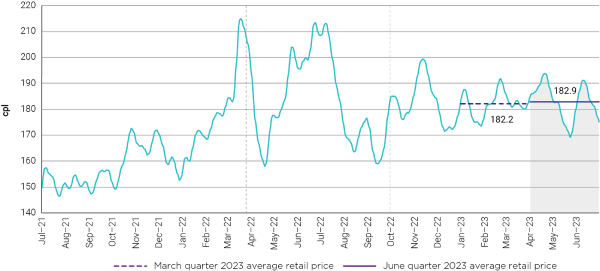Average retail diesel prices in Australia’s five largest cities (Sydney, Melbourne, Brisbane, Adelaide, Perth) continued to decrease during the June quarter 2023 to similar levels as average retail petrol prices, the ACCC’s latest petrol monitoring report shows.
Quarterly average retail diesel prices in the five largest cities were 186.6 cents per litre (cpl), a decrease of 13.1 cpl from the March quarter 2023. Quarterly average retail petrol prices were 182.9 cpl.
Since the December quarter 2022, quarterly average retail diesel prices decreased by 36.3 cpl, or more than 16 per cent. In the month of June 2023, average retail diesel prices in the five largest cities (181.2 cpl) fell below average retail petrol prices in the five largest cities (183.7 cpl) for the first time since January 2022.
“The decline in diesel prices in the June quarter will have brought welcome relief to industry and owners of diesel vehicles,” ACCC Commissioner Anna Brakey said.
Motorists often see petrol and diesel prices on price boards, and over the long term both prices have broadly tended to follow similar movements.
However different influences affect benchmark prices for refined petrol and diesel. Following the Russian invasion of Ukraine the benchmark price for refined diesel (Singapore Gasoil 10 ppm) rose significantly above the benchmark for refined petrol (Mogas 95), as global supply of refined diesel decreased.
“In the June quarter a number of international factors influenced the fall in diesel prices including further exports of diesel and gasoil from Russia despite sanctions, a decline in North American and European consumption, and an unexpected build-up in diesel inventories,” Ms Brakey said.
Monthly average retail diesel prices and retail petrol prices in the 5 largest cities in nominal terms: 1 July 2021 to 30 June 2023 – cents per litre (cpl)

Source: ACCC calculations based on data from FUELtrac.
Notes: The shaded area in the chart represents the June quarter 2023. The green dotted line indicates when the Russian invasion of Ukraine began (24 February 2022).
“Retail diesel and petrol prices have trended higher in July and August, following increases in international crude oil and refined diesel and petrol benchmark prices, and a weaker AUD-USD exchange rate,” Ms Brakey said.
Retail petrol prices remained stable in the quarter
In Australia’s five largest cities, quarterly average retail petrol prices were 182.9 cpl, a marginal increase of 0.7 cpl from the March quarter 2023.
The following chart shows that seven-day rolling average retail prices were relatively stable in the first half of this year, staying within a 24.4 cpl band.
Seven-day rolling average retail petrol prices in the 5 largest cities in nominal terms: 1 July 2021 to 30 June 2023 – cents per litre (cpl) p>

Source: ACCC calculations based on data from FUELtrac.
Notes: The shaded area in the chart represents the June quarter 2023. The 2 dotted lines indicate the cut in fuel excise from 30 March 2022 and the restoration of full excise from 29 September 2022. A 7-day rolling average price is the average of the current day’s price and prices on the 6 previous days.
Quarterly average retail petrol prices increased in the three smaller capital cities in the June quarter 2023: Canberra by 3.9 cpl, Darwin by 1.8 cpl and Hobart by 1.6 cpl. Average prices in Darwin (182.4 cpl) were below the average retail price across the five largest cities (182.9), while average prices in Canberra and Hobart were above.
In the June quarter 2023, average retail petrol prices across more than 190 regional locations the ACCC monitors were 185.3 cpl. This was a slight increase of 2.2 cpl from the previous quarter.
Average retail petrol prices in regional locations were 2.4 cpl higher than average retail petrol prices in Australia’s five largest cities.
Consumer attitudes to petrol
The Australasian Convenience and Petroleum Marketers Association (ACAPMA) 2022 National Monitor of Fuel Consumer Attitudes report shows that price is the key driver of choice for motorists when they fill up.
ACAPMA’s latest report into consumer attitudes also found that fuel price apps were the most popular method for consumers to search for better prices. 34 per cent of survey respondents reported using fuel price apps to search for prices in 2022, up from 19 per cent in 2019.
“With prices currently at higher levels, we strongly encourage consumers to make use of the free fuel price comparison apps and websites to find the cheapest petrol in their area,” Ms Brakey said.
Note to editors
‘Petrol’ means regular unleaded petrol (RULP) unless otherwise specified.
Singapore Mogas 95 Unleaded (Mogas 95) is the relevant international benchmark for the wholesale price of petrol in Australia. Singapore Gasoil with 10 parts per million sulphur content (Gasoil 10 ppm) is the international benchmark for the wholesale price of diesel.
This report is for the quarter to end of June 2023. The report also provides annual data for 2022–23.
The ACCC uses a seven-day rolling average basis to analyse movements in daily retail petrol prices. A seven-day rolling average price is the average of the current day’s price and prices on the six previous days.
Background
The ACCC has been monitoring retail prices in all capital cities and over 190 regional locations across Australia since 2007.
On 14 December 2022, the Treasurer issued a new direction to the ACCC to monitor the prices, costs and profits relating to the supply of petroleum products in the petroleum industry in Australia and produce a report every quarter for a further three years.




